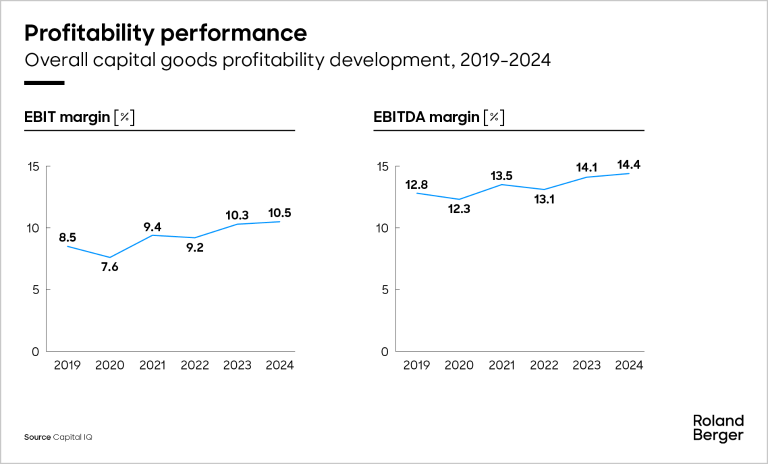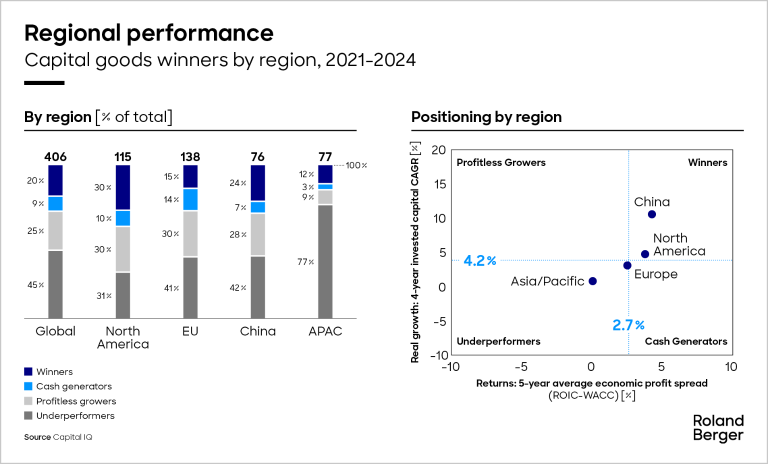Roland Berger advises companies on industrial goods and services, combining outstanding industry expertise and excellent technical know-how.


Capital goods 2024: Another tough year across the industry but profits hold up
Our annual report on the capital goods industry finds that profits rose slightly despite declining growth, with the US remaining a bright spot
Challenging global economic conditions and continued uncertainty weighed heavily on capital goods players in 2024, producing mixed financial and regional results. While overall margins rose, revenues fell by about 2% as costs remained high and investments were delayed. Europe and China were particularly hard hit, although the US weathered the storm. The outlook for 2025 and beyond paints a similar picture. Below we review the industry’s financial and regional performance, and look at the challenges that lie ahead – and how players can address them. In addition, we look in detail at the performance, challenges and priorities of each of the main capital goods segments in separate deep dives.

"In a year of uncertainty, resilience paid off – profits held firm even as revenues slipped."
Review and outlook
Coming into 2024, it was difficult to predict what the year held in store for capital goods players. The prevailing climate was one of continued uncertainty, with intensifying geopolitical tensions, volatile inflation and a packed schedule of important elections (US presidency, European parliament, Indian lower house and national elections in Japan, France, the UK and South Africa, for example). However, there was also cautious optimism as 2023 had been a very positive year for the industry, driven by continued strong post-pandemic demand for industrial goods and services, easing of supply chains and the retention of higher price levels set in 2020 to 2022. In the end, 2024 turned out to be a year of mixed results.
Global summary: Revenues down, profits stable
On the negative side, the industry’s post-pandemic trend of revenue growth ended. Global revenue contracted by about 2% year on year, falling to USD 3.248 billion from a high of USD 3.306 billion in 2023. This was largely driven by overall economic conditions rather than structural challenges in demand for industrial products and services. Ultimately, the combination of high costs (particularly higher interest rates) and high uncertainty delayed investments, especially where there were no government incentives to invest. In addition, inventory management shifted back from the "just-in-case" model prevalent in the aftermath of the COVID pandemic to a more efficient "just-in-time" approach.
"Winners aren't waiting for stability – they're building it with cost focus, smart tech, and bold strategy."
More positively, global margins held firm in 2024. EBIT and EBITDA levels, which were already high, expanded by around 0.2-0.3% to 10.5% and 14.4%, respectively. This growth was the result of players – especially those in the West – shifting focus towards cost optimization and performance management programs, while at the same time improving supply-chain efficiencies and ensuring price stability despite lower input costs. New technologies, such as AI, played a part here. The initial AI buzz is now shifting from exploration and theory to the tactical and achievable, and was backed up by a significant increase in investment between 2023 and 2024. However, a gap is forming between the AI haves and have nots, with more experienced players beginning to see the first results. To date, these are in internal efficiency improvements rather than user/customer-facing saleable offers.
"As the global economic tide turned, only those who adapted quickly stayed afloat."
Regional summary: US outperforms stagnating Europe and declining China
The regional picture was as mixed as the economic one in 2024, with the US faring well while China and Europe struggled.
Overall, North America strengthened its position in our Winners category (superior performers; see Methodology box). This was despite decision making in the US being delayed until after the presidential elections in November. However, significant uncertainty remains in the country following the change in administration.
China also remains in the Winners category. However, the country’s capital goods market is experiencing a significant decline, dipping below previously forecasted levels.
In the EMEA region, Europe stagnated in the Underperformer category in 2024, with little change in real growth or returns compared to 2023. High energy costs remain a major challenge across the EMEA region.
Global outlook: The key challenges ahead – and how to address them
Short-term (2025)
Four areas will be key to the short-term future of the capital goods industry:
"In 2024, capital goods players learned the hard truth: agility beats size when uncertainty rules."
Economic & trade uncertainty: As mentioned above, uncertainty is already rife in the industry and could be exacerbated by a potential trade war. Countries with a trade deficit with the US will likely face targeted tariffs, for example. As a result, companies are delaying footprint decisions on, for example, manufacturing and supply-chain location strategies. "Local-for-local" manufacturing strategies are still expected but are being pushed back. For example, the shift away from China-centric supply chains, a shift that is partially on hold due to an unwillingness to invest in production assets because of the high degree of general uncertainty.
Operational & cost strategies: In operations, the push towards automation continues as a priority to address labor shortages. This is widely considered a “no-regrets” move. In addition, supply-chain costs have been under attack in 2024, eating into near-term savings potential. This has left hard restructuring or product cost as the key remaining savings levers. Product portfolio management and simplification will therefore likely be important cost-saving measures to introduce in 2025 for payoff by the end of the decade. Meanwhile, cost-cutting efforts are also shifting to product design. As most major cost initiatives were completed in 2024, there will be a focus on value analysis and value engineering (VAVE), engineering cost reductions and complexity reduction.
Pricing & market dynamics: Major question marks remain over whether companies can maintain pricing and if tariff-driven cost increases can be passed on to customers. In addition, affordability concerns are growing, meaning someone in the value chain will likely be squeezed.
Strategic focus: As they search for new growth opportunities, companies will need to re-evaluate their core business areas and decide where to focus their efforts. Large conglomerates should also note the mounting evidence suggesting activist investors are pushing to break them up so that they have more focused portfolios.
Mid- to long-term (2026 and beyond)
Uncertainty will remain the dominating factor in the mid- to long-term future of the industry. In particular, tariffs, the potential for a recession in North America and high energy prices in Europe will be key issues.
Emerging as a Winner will therefore require a competitive cost base and clear strategic focus on core businesses. This will ensure the flexibility to quickly react to changing economic circumstances, for example, adapting the supply chain to avoid tariffs and de-risk in light of rising geopolitical tensions. In addition, companies should continue investing in new technologies (AI, advanced robotics, next generation manufacturing, etc.) to leverage their advantages earlier and more efficiently than their competition, thereby creating additional separation. While Winners will have a head start, they will need to continue to evolve, drive their agenda and avoid getting bogged down in uncertainty avoidance efforts to stay ahead.















